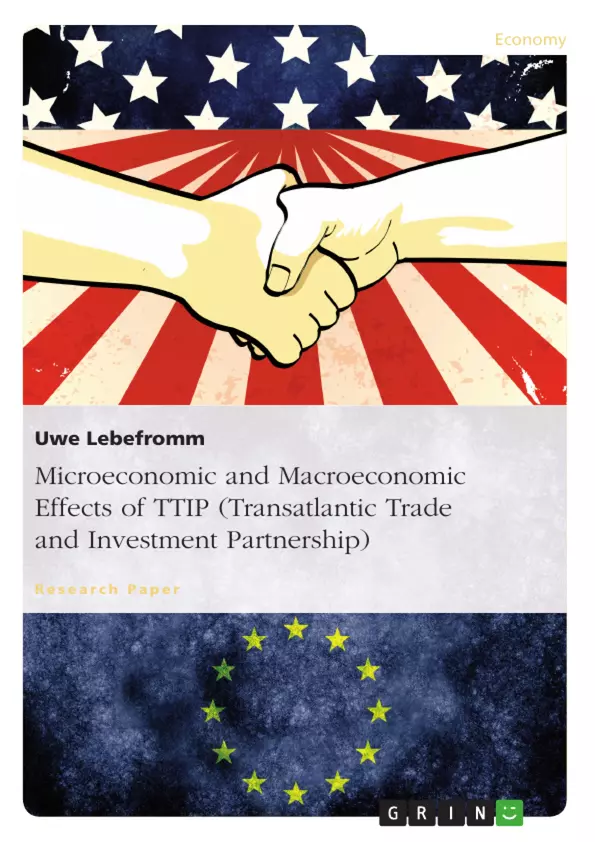The first part is referred to the essential components of TTIP. These include the negotiating institutions, the central regulations and the objectives associated with it.
Chapter three forms the core of this essay. In the first part microeconomic effects on selected sectors in the EU and USA are carried out. The used econometric model MIRAGE will be explained and the calculated results are demonstrated. In the second part of chapter three macroeconomic effects are considered, which have been calculated on the basis of the MELITZ model.
The central sources of this chapter are the following studies: “Dimensions and Effects of a Transatlantic Free Trade Agreement between the EU and US. from IFO-institute in Munich.
To address also effects to third countries, as an example two studies related to turkey and china are used.
Chapter 5 gives a summary and check whether the hypothesis of this essay has been proofed.
Inhaltsverzeichnis (Table of Contents)
- Introduction
- Topical Issues of the Research
- The purpose and objective of the study
- Main hypothesis and auxiliary hypotheses
- Research Methodology
- Structure of Work
- The Transatlantic Trade and Investment Partnership
- Background
- The Multilateral Trade Liberalization
- General Agreements on Tariffs and Trade (GATT)
- World Trade Organization (WTO)
- DOHA Development Round
- Negotiating Objects and Integration Motives of TTIP
- Economic Effects of TTIP
- Microeconomic Effects on Sectors of Economic Activity
- Scenario of Selected Sectors
- The MIRAGE Model
- The Demand Side
- The Supply Side
- Capital and Investment
- Agriculture Modelling
- Results of the ifo-Study
- Effects Terms of Trade in Sector
- Multilateral World-Trade-System and the Rule of Origin
- Summary of the Microeconomic Effects
- Macroeconomic Effects
- The Market Model of Monopolistic Competition
- The MELITZ Model
- Productivity in the Melitz Model
- Free Market Entry Condition (FE)
- Zero Cutoff Profit (ZCP)
- Comparison of Autarky and Free Trade
- Impact of Trade Liberalization
- Simulation Results of the TTIP Study
- Reallocation Effects
- Effects on Macroeconomic Variables
- Effects on Labor Market
- Summary of the Macroeconomic Effects
- The Role of Standards in TTIP – Three Examples
- Chemistry
- Agriculture
- Data Protection
- TTIP Effects to Third Countries
- Effects on Turkey Economy
- Trade Relations between EU-US and Turkey
- Methodology
- Empirical Results
- Effects on Chinese Economy
- China's Trade Statistics
- Methodology
- Empirical Results
- Evaluation the Results
- The potential economic benefits and challenges of TTIP
- The impact of TTIP on different sectors of economic activity
- The role of standards and regulations in the TTIP agreement
- The implications of TTIP for third countries, particularly Turkey and China
- The broader implications of TTIP for the global economy
Zielsetzung und Themenschwerpunkte (Objectives and Key Themes)
This research paper investigates the microeconomic and macroeconomic effects of the Transatlantic Trade and Investment Partnership (TTIP). The study aims to analyze the potential impact of TTIP on various sectors of economic activity, including trade, investment, and labor markets, both within the EU and the US, and on third countries like Turkey and China.
Zusammenfassung der Kapitel (Chapter Summaries)
The research paper explores the various aspects of the Transatlantic Trade and Investment Partnership (TTIP), focusing on its potential economic effects. The first chapter provides an introduction to the topic, outlining the research objectives, hypotheses, methodology, and the structure of the paper. The second chapter delves into the background of TTIP, discussing the historical context of multilateral trade liberalization and the motivations behind TTIP negotiations. The third chapter analyzes the economic effects of TTIP, covering both microeconomic and macroeconomic implications. This chapter examines the potential impact on specific sectors of economic activity, utilizing models like MIRAGE and MELITZ to simulate the effects of trade liberalization. The fourth chapter explores the potential effects of TTIP on third countries, specifically focusing on Turkey and China. The chapter examines the trade relations between the EU-US and these countries and utilizes empirical data to analyze the potential impact of TTIP.
Schlüsselwörter (Keywords)
The primary keywords and focus topics of the research paper encompass the Transatlantic Trade and Investment Partnership (TTIP), its microeconomic and macroeconomic effects, trade liberalization, investment, labor markets, standards and regulations, third-country effects, Turkey, China, and the global economy. The study also utilizes specific econometric models such as MIRAGE and MELITZ to analyze the potential impact of TTIP.
- Citation du texte
- Uwe Lebefromm (Auteur), 2015, Microeconomic and Macroeconomic Effects of TTIP (Transatlantic Trade and Investment Partnership), Munich, GRIN Verlag, https://www.grin.com/document/302871



